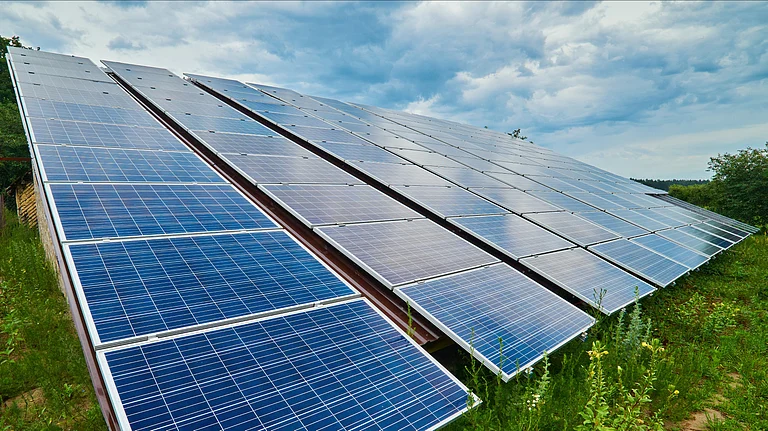India’s foreign policy is anchored in strategic autonomy. In the climate arena, this includes the nurturing of new global platforms that advance collective solutions. The International Solar Alliance now has more than 100 members and partners with a target of mobilising 1,000GW of solar capacity and $1trn in investment by 2030.
The Coalition for Disaster Resilient Infrastructure today unites more than 50 member countries and nine partner organisations around the cause of climate-proof infrastructure. More recently, India has promoted the Global Biofuels Alliance to accelerate sustainable bioenergy and the Big Cat Alliance to protect biodiversity and ecosystems.
These initiatives mark a shift from India being simply a negotiator pushing for maximum policy space for its huge development imperatives to becoming a convener and agenda-setter. They signal a push for global institutions to move beyond negotiations towards delivering outcomes in areas like solar energy, resilient infrastructure and biofuels.
Walking the Talk
India’s climate diplomacy rests on strategic multi-alignment, working with a variety of international groupings. Within the G20, India secured consensus for the admission of the African Union, giving the Global South a stronger institutional voice.
Within BRICS [Brazil, Russia, India, China, South Africa and five other members], India has pushed for recognition of climate finance as a pressing need and has linked this effort to its aspirations to host the Conference of Parties (COP33) in 2028. At the United Nations, India has advanced triangular cooperation through initiatives such as the India Brazil South Africa (IBSA) Fund and the India-UN Development Partnership Fund, which has already supported projects in more than 50 developing countries.
The future of global climate governance will be shaped not only by targets but by how fairly burdens and opportunities are shared
Through partnerships, India demonstrates it can safeguard national interests while engaging constructively, strengthening its credibility as a bridge between advanced economies and the Global South.
India’s domestic progress reinforces its international credibility. As of July 2025, non-fossil sources account for 50.3% of the country’s installed electricity generation capacity. Solar alone contributes 24.3%, wind 10.6%, large hydro 10.1%, small hydro 1%, biomass 2.2%, waste-to-energy 0.2% and nuclear 1.8%. Therefore, India has already fulfilled one of its three Nationally Determined Contribution (NDC) commitments, five years ahead of schedule.
The second quantified NDC target is to reduce emissions intensity of GDP by 45% from 2005 levels by 2030. India had already achieved a 36% reduction by 2020, putting it well on track.
The third target is to create an additional carbon sink of 2.5–3bn tonnes through forest and tree cover. The biennial State of the Forest Report 2023 showed that carbon stock in India’s forests and trees had already increased in 2021 by about 2.29bn tonnes from 2005 levels. With an average annual increase of roughly 150mn tonnes between 2017 and 2021, India might also meet this goal ahead of schedule.
Equally striking are India’s relatively low greenhouse gas emissions. In 2023, per capita emissions were 2.9 tonnes of carbon dioxide equivalent, less than half the world average of 6.7. The contrast with advanced economies is stark: the US at 17.2, Canada at 20.4, Japan at 8.3 and the European Union at 6.9.
A Pragmatic Blueprint
India is creating domestic frameworks that link policy, finance and regulation. The 2023 Carbon Credit Trading Scheme sets emission targets for energy-intensive industries while enabling offset projects across sectors, backed by methodologies and monitoring frameworks that aim to ensure transparency and credibility.
Complementing this, the Green Credit Rules establish a system of tradeable credits for activities such as afforestation, sustainable water management and waste reduction. These mechanisms encourage innovation and accountability across industry and civil society, while also aligning with Article 6 of the Paris Agreement.
While being committed to tackling climate change with huge domestic actions, India recognises that the pace of transition must be balanced with development imperatives and priorities. Rapid decarbonisation without adequate finance, technology access and affordable critical minerals risks diverting resources from poverty eradication, health and education.
India has consistently highlighted inequity in global emissions and finance. At 2.9 tonnes of emissions per capita, India contributes minimally to cumulative climate burdens, yet it faces disproportionate adaptation challenges.
At COP29 in Baku and ahead of COP30, India argued that climate finance pledges must be met with real public funding, not just private flows. It is called the $300bn New Collective Quantified Goal for 2035 inadequate, and stresses concessional finance, technology transfer and debt-sensitive support for the Global South.
Holding Steady
The future of global climate governance will be shaped not only by targets but also by implementation and how fairly burdens and opportunities are shared. India’s balanced pathway shows that ambition can coexist with pragmatism. Domestic action is being scaled up through solar expansion, bioenergy, storage and nuclear power, while international diplomacy is giving voice to developing countries.
At Belém, India is likely to be a strong voice of support for Brazil, in ensuring that the climate agenda moves apace on the global level. This counts as global climate action wavers, with the US and even once-ambitious Europeans nations retreating in the scale of their ambitions.
Strategic autonomy allows India to innovate and lead new coalitions, building bridges among diverse blocs. Complemented by think tanks and NGOs driving global climate action, India asserts itself as a leader in a multipolar world.
Puri is distinguished fellow at The Energy and Resources Institute
Kedia is director at The Energy and Resources Institute











